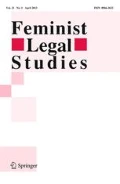Abstract
This article examines the way in which the sublime comes to matter within various eighteenth century legal discourses, particularly in the work of Thomas Hobbes, John Locke and Edmund Burke. The essay seeks also to relate the theoretical works of these philosophers and lawyers to practical legislative developments of the period, in particular, the passage of the Black Act in1726 and the Marriage Act in 1753. The sublime comes to matter to the law in this period in the sense that philosophical conceptualizations of the sublime in terms of power and transcendence become increasingly significant to representations of the nature and function of English law. Such theoretical accounts of the law as are found in the work of Hobbes, Locke, and Burke, moreover, translate into juridical practices designed to affirm the status of the law as a transcendentally sublime source of political authority in the eighteenth century. This article subjects that understanding of the law to a feminist critique that draws upon the work of the French philosopher, Luce Irigaray. It will be shown that the sublime within Western thought is generally associated with a sense of dread as to the possibility of the annihilation of consciousness. This ontological dread entails, in Jean Francois Lyotard’s terms, a recognition of the possibility of “nothing further happening” to the subject. Within Western discourse, this dread is projected onto, or made material in the form of, some ‘other’ that is, in Irigaray’s estimation, most usually feminine. Thus, the sublime comes to matter in this second, ontological sense and it is within this context that the transcendental sublime emerges as a response to a sense of dread that is projected on to some material, feminine, or feminised, ‘other’. In eighteenth century legal discourse, this ‘other’ take the form of the ‘state of nature’, or the revolutionary mob, or the revolutionary female who signifies more than anything a return to animality and chaos –an ontological and political fall from grace. The Black Act and the Marriage Act, with their shared emphasis upon the preservation of political stability and patriarchal property rights, may in this context be regarded as manifestations in the legal domain of the metaphysical principles of the transcendental sublime – with its emphasis upon an escape from, and a control of, the dreadful, feminine ‘other’.
Similar content being viewed by others
REFERENCES
Allen, R.T., “The State and Civil Society as Objects of Aesthetic Appreciation”, British Journal of Aesthetics 16 (1976), 235-247.
Ashfield, A. &de Bolla, P., The Sublime: A Reader in Eighteenth-Century Aesthetic Theory (Cambridge: Cambridge University Press, 1996).
Blakemore, S., Burke and the fall of Language: The French Revolution as Linguistic Event (Hanover: University Press of New England, 1988).
Bruyn, F. de, The Literary Genres of Edmund Burke: The Political Uses of Literary Form (Oxford: Clarendon Press, 1996).
Burke, E., A Philosophical Enquiry into the Orig in of our Ideas of the Sublime and the Beautiful, ed. James T. Boulton (Oxford: Blackwell, 1990a).
Burke, E., A Letter to the Nation Assembly (Oxford: Woodstock, 1990b).
Burke, E., Reflections on the Revolution in France (London: Penguin 1985).
Burke, E., “Letter on a Regicide Peace”, in TheWorks of Edmund Burke, Vol. V (Michigan: Scholarly Press, 1965a), 225-226.
Burke, E., “Letter to a Noble Lord”, in Works (Michigan: Scholarly Press, 1965b), 186-188.
Burke, E., Speech on a Bill for the Repeal of the Marriage Act, in Works (Michigan: Scholarly Press, 1965c), 134-136.
Foucault, M., Discipline and Punish (London: Penguin, 1997).
Freud, S., Introductory Lectures on Psychanalysis (London: Penguin, 1974).
Fromm, E., The Anatomy of Human Destructiveness (London: Random House, 1997).
Furniss, T., Edmund Burke' Aesthetic Ideology (Cambridge: Cambridge University Press, 1993).
Giddens, A., Modernity and Self-Identity (Oxford: Blackwell, 1991).
Gonda, C., Reading Daughters' Fictions (Cambridge: Cambridge University Press, 1996).
Hay, D., “Property, Authority and the Criminal Law”, in Albion' Fatal Tree, ed. D. Hay (London: Penguin, 1975), 25-37.
Heidegger, M., “What is Metaphysics?” in Basic Writings, ed. D. Farrell (Oxford: Blackwell, 1992), 90-97.
Hill, B., Eighteenth-Century Women: An Anthology (London: George Allen and Unwin, 1984).
Hobbes, T., Leviathan (London: Penguin, 1986).
Huhn, T., “The Kantian Sublime and the Nostalgia for Violence”, Journal of Aesthetics and Art Criticism 53/3 (1995), 268-279.
Irigaray, L., “Body Against Body: In Relation to the Mother”, in Sexes and Genealogies, edited and translated by Gillian C. Gill (New York: Columbia University Press, 1987), 1-17.
Irigaray, L., Speculum of the Other Woman (Ithaca: Cornell University Press, 1985).
Kierkegaard, S., The Concept of Dread (London: Macmillan, 1944).
Kristeva, J., The Powers of Horror (New York: Columbia University Press, 1982).
Lacoue-Labarthe, P., “Sublime Truth”, Cultural Critique, winter 2 (1992), 207-228.
Locke, J., Second Treatise of Government, ed. D. Wootton (London: Penguin, 1993a).
Locke, J., First Treatise on Government, ed. D. Wootton (London: Penguin, 1993b).
Lyotard, J-F., “The Sublime and the Avant-Garde”, in The Lyotard Reader, ed. A. Benjamin (Oxford: Blackwell, 1989), 196-211.
Sharpe, J.A., Crime in Early Modern England, 1550-1750 (London: Longman, 1984).
Sircello, G., “How is a Theory of the Sublime Possible?” The Journal of Aesthetics and Art Criticism 51/4 (1993), 541-549.
Thompson, E.P., Whigs and Hunters: The Origin of the Black Acts (London: Penguin, 1992).
Trumbach, R., The Marriage Act of 1753: Four Tracts (London: Garland, 1984).
West, R., “Jurisprudence and Gender”, University of Chicago Law Review 55 (1988), 1-67.
Zizek, S., The Sublime Object of Ideology (London: Verso, 1989)
Author information
Authors and Affiliations
Rights and permissions
About this article
Cite this article
Chaplin, S. How the Sublime Comes to Matter in Eighteenth Century Legal Discourse – an Irigarayan Critique of Hobbes, Locke and Burke. Feminist Legal Studies 9, 199–220 (2001). https://doi.org/10.1023/A:1012536421573
Issue Date:
DOI: https://doi.org/10.1023/A:1012536421573




